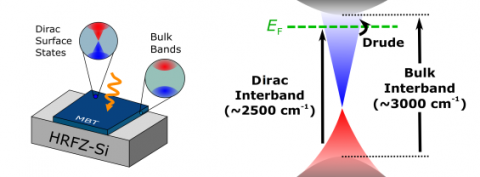Time Reversal Simmetry Breaking in Magnetic Topological Insulator

The importance of electronic band topology is unequivocally recognized in condensed matter physics and new states of matter. Examples are the recently discovered 3D topological insulators and Dirac and Weyl topological semimetals. 3D topological insulators are naturally stratified quantum materials characterized by a massless Dirac electronic dispersion with spin–momentum locking at the surface. Novel electromagnetic and transport properties emerge from these topological states, ranging from the Quantum anomalous Hall effects, half-quantized surface anomalous Hall conductivity, multiple harmonic terahertz generation, and exotic electromagnetic effects like the chiral anomaly and axion electrodynamics.
These last properties provide an effective low-energy mapping of high-energy physics phenomena, opening the route towards innovative “particle-physics on the table” experiments.
In this framework, one distinguishing feature of 3D topological materials is the presence of electronic states robust against external perturbations and protected by several symmetries, including time reversal and parity. In the paper “Electrodynamics of MnBi2Te4 Intrinsic Magnetic Topological Insulator” recently published on NPJ Nature ASIA Materials [1] by L. Tomarchio, L. Mosesso and S. Lupi, in collaboration with Prof. Ke He from Tsinghua University, and Beijing Academy of Quantum Information Sciences, the effects of time-reversal symmetry breaking are investigated on topological massless Dirac states.
The time reversal breaking is induced by the insurgence of magnetic order in the MnBi2Te4 crystal structure, opening an exchange gap at the Dirac node. This gap opening corresponds to a finite mass for Dirac fermions at the surface of MnBi2Te4. Topological insulators, and Weyl and Dirac semimetals not only represent a class of Quantum Materials for quantum technology applications but offer also a valuable platform for combining condensed matter with high-energy particle physics in a very useful cross-fertilization interaction. [1] L. Tomarchio et al., NPG Asia Materials volume 14, Article number: 82 (2022)
Authors
Luca Tomarchio, Lorenzo Mosesso e Stefano Lupi
Article
NPG ASIA MATERIALS
https://www.nature.com/articles/s41427-022-00429-w
